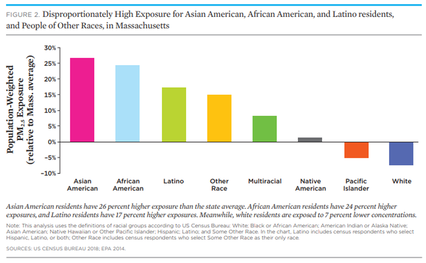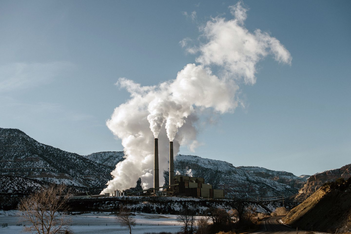 By definition, air pollution is a mix of hazardous solid particles and gases in the air. Vehicle emissions, factory chemicals, ozone (smog), dust, pollen, and mold spores are all sources of air pollution. Traffic-Related Air Pollution (TRAP) from motor vehicles and particulate matter (PM), are responsible for many threats to human health. Air pollution is a risk to everyone, but in particular, people of certain racial and ethnic groups face a much greater risk. These disparities in communities of color are especially evident in Massachusetts. One 2019 study found that Asian American residents in Massachusetts are exposed to 36% more PM air pollution than white residents; African American residents are exposed to 34% more TRAP than whites, and Latino residents are exposed to 26% more. A major part that plays into these disproportionate effects on people of color are factors relating to racism and class bias. For decades, decisions in Massachusetts about transportation, housing, and land use have left people of color breathing in excess amounts of polluted air. Decisions about where to place highways and invest in public transportation and where to build houses have left people of color at a disadvantage, placing communities at a higher exposure for air pollution and increasing their risk of developing respiratory diseases, cardiovascular diseases, and cancer. There are several ways to make Massachusetts cleaner and improve the health of high-risk communities. New transportation technologies (electric trucks, buses, and cars) are cleaner and can reduce TRAP. By implementing these technologies near communities of color, the air pollution in Massachusetts will drastically decrease. Providing better active-travel options, like bicycle and walk paths, can reduce exposure to TRAP. Schools can also help by following the U.S. EPA’s Clean School Bus Campaign to clean up dirty bus emissions. The state can develop housing with better conditions and use high-efficiency particulate air (HEPA) filtration to make the air cleaner from congested highways. In addition, adding gardens, parks, and street-side trees can improve air quality. By providing communities of color with cleaner technology, better public transportation for walking and biking, and using filters and trees to help clear the air, it is feasible to improve the health of everyone and diminish the health disparities among racial and ethnic groups. Works Cited “Air Pollution and Your Health.” National Institute of Environmental Health Sciences, U.S. Department of Health and Human Services, www.niehs.nih.gov/health/topics/agents/air-pollution/. “Air Pollution.” MedlinePlus, U.S. National Library of Medicine, 14 Aug. 2020, medlineplus.gov/airpollution.html. “Inequitable Exposure to Air Pollution from Vehicles in Massachusetts.” Union of Concerned Scientists, https://www.ucsusa.org/sites/default/files/2020-05/inequitable-exposure-to-vehicle-pollution-ma.pdf “10 Tips to Protect Yourself from Unhealthy Air.” American Lung Association, www.lung.org/clean-air/outdoors/10-tips-to-protect-yourself. Comments are closed.
|
|

